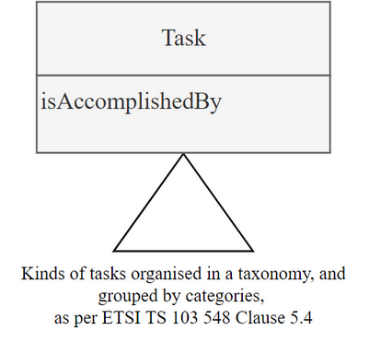SAREF patterns for tasks
Introduction
Tasks are defined as goals for which a device is designed (from a user perspective).
The figure below illustrates the main classes and properties in the SAREF Core patterns for Tasks.

Creating tasks
SAREF extensions should reuse or create specific instances of the class saref:Task.
The identifier and the label of an instance of task should start with a capital letter and should not contain "Task". The comment may mention "task".
EXAMPLE:
ex:Lighting a saref:Task ;
rdfs:label "Lighting"@en ;
rdfs:comment "The task of lighting involves strategically designing and controlling light sources to achieve optimal visibility, functionality, and aesthetic appeal in a given space."@en.Specializing tasks
SAREF extensions may define a taxonomy of tasks using skos:broader and skos:narrower.
The identifier, the label, and the comment of an instance of saref:Task should explicit its position in the taxonomy of tasks.
EXAMPLE: ex:AmbianceLighting and ex:SecurityLighting are specializations of ex:Lighting.
ex:SecurityLighting a saref:Task ;
skos:broader ex:Lighting ;
rdfs:label "Security Lighting"@en ;
rdfs:comment "A kind of task accomplished by lighting devices intended to deter or detect intrusions or other criminal activity occurring on a property or site. It can also be used to increase a feeling of safety."@en .Categorizing tasks
SAREF extensions and applications may define categories of tasks by creating sub-classes of saref:Task.
The identifier, the label, and the comment of a sub-class of saref:Task should explicit its position in the hierarchy of task classes. The identifier should end with "Task".
EXAMPLE: The class ex:SafetyTask groups tasks related to safety.
ex:SafetyTask a owl:Class ;
rdfs:subClassOf saref:Task ;
rdfs:label "Safety Task"@en ;
rdfs:comment "Class of tasks related to safety."@en .Specializing OPs and DPs related to tasks
SAREF extensions and applications shall not define sub-properties of the following properties:
- saref:accomplishes
- saref:isAccomplishedBy